Physical Address
304 North Cardinal St.
Dorchester Center, MA 02124
Physical Address
304 North Cardinal St.
Dorchester Center, MA 02124
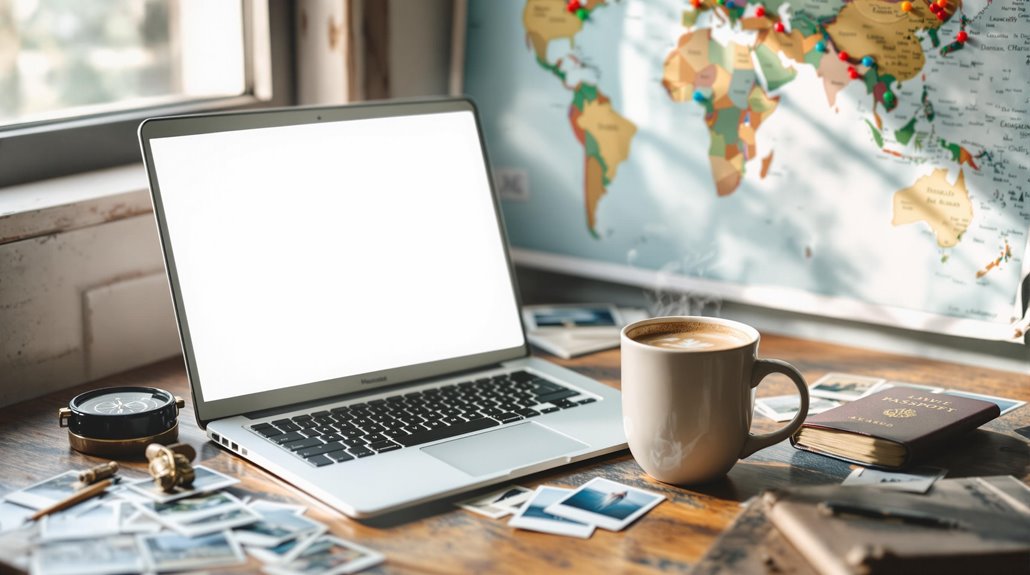
Kickstart your travel blogging journey with proven steps that transform wanderlust into profitable online content.
To start a travel blog, you’ll need to choose a specific niche that matches your expertise and passion, then select a memorable domain name under 15 characters. Set up WordPress hosting through providers like Bluehost or Hostinger, install essential plugins for SEO and security, and customize a mobile-responsive theme. Create compelling content, optimize for search engines, establish social media presence, and implement monetization strategies like affiliate marketing. Discovering the finer details of each step will set you up for blogging success.
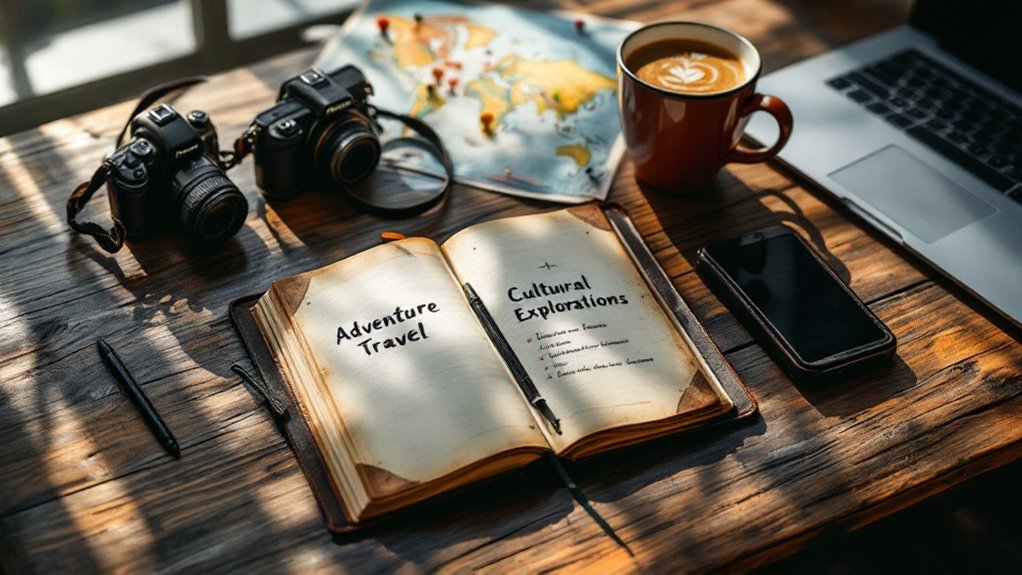
When starting a travel blog, choosing the right niche can make the difference between creating a thriving online presence and getting lost in the vast sea of generic travel content.
To find your perfect niche, start by evaluating your personal expertise and passions, whether that’s adventure photography, sustainable tourism, or luxury accommodations. The rising popularity of plant-based living has created exciting opportunities for travel content focused on healthy, sustainable lifestyles. Cities like European vegan capitals are becoming increasingly popular among conscious travelers.
Look for growing market segments with proven demand by researching keywords and trends. While budget travel and sustainable tourism show steady growth, emerging niches like astrotourism and rail journeys offer exciting opportunities with less competition.
Consider combining multiple angles to create a unique perspective, such as vegan food tours in Southeast Asia or solo female adventure photography. Digital nomads and remote workers represent a rapidly expanding travel segment that combines lifestyle content with destination guides.
Many travelers seek out hidden vegan destinations for unique culinary experiences, making plant-based travel an increasingly viable niche.
Don’t forget to align your chosen niche with your target audience’s demographics and preferences, ensuring you’re meeting specific needs in the market.
Now that you’ve identified your travel blog niche, selecting the right domain name will help establish your brand identity and make it easier for readers to find you.
Keep your domain name under 15 characters, avoiding hyphens and numbers that could confuse visitors. Choose memorable words that reflect your niche while incorporating 1-2 relevant keywords naturally, such as “adventure” or “luxe” for luxury travel content. Consider using creative word combinations to make your domain name more unique and engaging.
Short, sweet, and keyword-rich: Your domain name should instantly tell visitors what your travel blog is all about.
Starting with a unique niche focus will help differentiate your blog from competitors and attract a dedicated audience.
Before finalizing your selection, verify domain availability through registrars like BlueHost and check if matching social media handles are free across platforms.
Consider your blog’s future growth potential, selecting a name that won’t limit your content expansion. Remember to prioritize brandability over trendy terms, and guarantee your domain name is easy to communicate verbally without requiring spelling explanations.
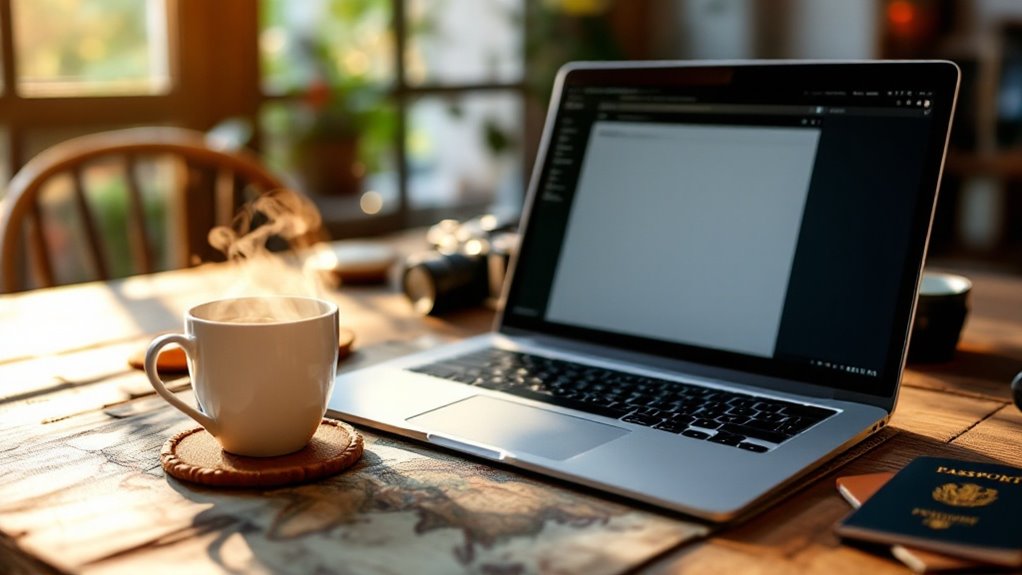
Setting up reliable web hosting and WordPress creates the foundation for your travel blog’s success. For beginners, choose between shared hosting providers like Bluehost or Hostinger, which offer affordable plans with one-click WordPress installation, free SSL certificates, and important features to get started. Select a provider that offers built-in security features to safeguard your travel blog against potential online threats.
Once you’ve selected a host, you’ll need to complete the WordPress installation process, which typically takes just 3-5 minutes through your provider’s control panel.
After installation, log in to your WordPress dashboard through yoursite.com/wp-admin to configure essential settings. Make sure to set your permalinks to “Post Name,” adjust your time zone, and enable automatic updates for security.
Don’t forget to install important plugins for SEO, security, and caching to optimize your site’s performance from day one.
The right WordPress plugins can transform your basic travel blog into a powerful, professional platform.
Start with essential SEO tools like Yoast SEO or Rank Math to optimize your content for search engines and improve your visibility. You’ll also need performance plugins like WP Rocket or LiteSpeed Cache to guarantee your site loads quickly, which is vital for keeping readers engaged.
For travel-specific features, install WP Travel Engine to handle tour bookings and Travelers’ Map to showcase your journeys with interactive routes. Social Snap helps you boost engagement with social sharing buttons that encourage readers to spread your content.
Don’t forget security – Wordfence or iThemes Security will protect your site from hackers and malware.
Finally, enhance your content presentation with tools like Photo Gallery by 10Web for stunning image displays and TablePress for organizing trip itineraries and budgets.
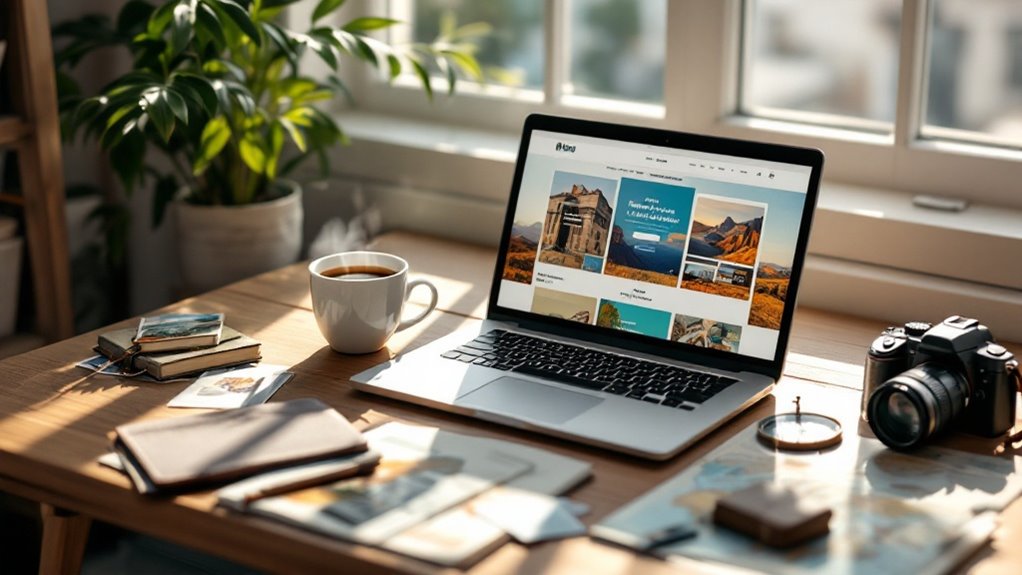
Selecting your travel blog’s theme ranks among the most essential decisions you’ll make, as it determines both your site’s visual appeal and functionality.
Regular theme updates and support ensure your blog stays secure and compatible with the latest WordPress versions.
When choosing your theme, prioritize options that offer built-in Google Maps integration, multiple post formats, and mobile-responsive designs to guarantee your content looks great across all devices.
Look for themes that provide robust customization capabilities through drag-and-drop builders like Elementor or Divi, allowing you to create unique layouts without coding knowledge.
Your chosen theme should score at least 80/100 on Google PageSpeed Insights and include essential features like lazy loading for images.
Don’t forget to verify WooCommerce compatibility if you plan to sell products or book tours, and confirm your theme includes pre-built templates specifically designed for travel content.
Building a successful travel blog requires establishing key foundational pages that’ll serve as your site’s backbone and provide essential information to your readers.
Start by creating core informational pages, including a compelling homepage that showcases your featured content, an about page that highlights your credentials and travel philosophy, and a professional contact page with your social media links. Make sure to design your blog with a visual-forward template to effectively display your content.
Next, develop destination-centric pages to organize your content geographically, including an interactive map of places you’ve visited and detailed destination hubs.
Don’t forget essential legal pages like your privacy policy, copyright notice, and affiliate disclosures.
Finally, create resource pages such as travel guides, gear recommendations, and an FAQ section to address common reader questions.
Remember to optimize each page with SEO elements like keyword-rich URLs and strategic internal linking.
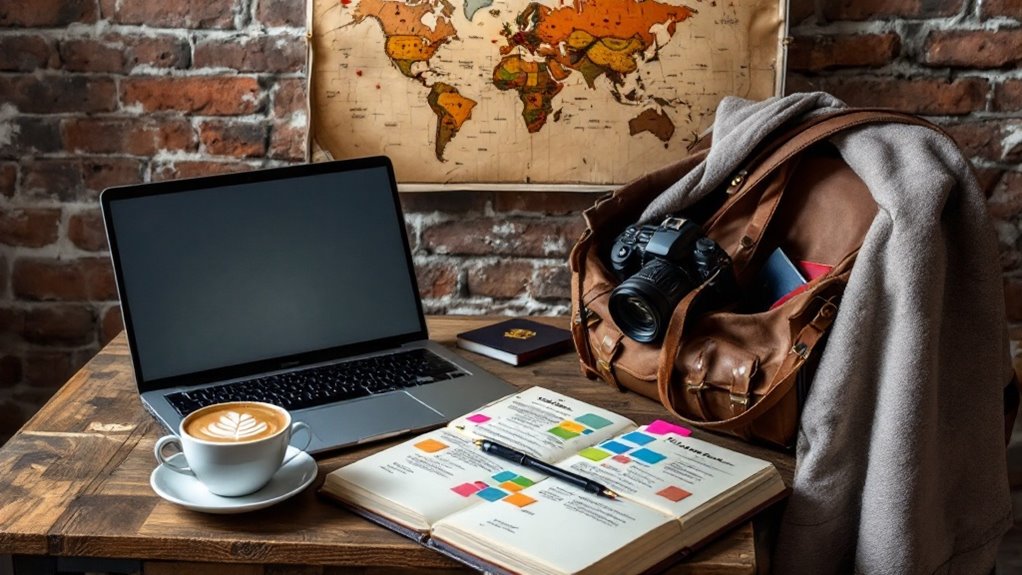
Once you’ve established your blog’s foundation, crafting a strategic content plan becomes essential for attracting and retaining engaged readers.
Start by defining clear objectives that align with your brand awareness goals, and conduct thorough audience research to understand your target readers’ preferences and pain points. Consider incorporating user-generated content to build authenticity and foster community engagement among your readers. For instance, sharing insights about vibrant Berlin neighborhoods can help showcase your expertise in featuring dynamic urban destinations. If your blog focuses on dietary preferences, highlighting destinations like plant-based dining in Kuala Lumpur can attract niche audiences seeking specialized travel content. Exploring historic sites like the National Mall can provide valuable content for readers interested in American heritage.
Success in content creation starts with crystal-clear goals and deep understanding of your audience’s needs and desires.
Create an editorial calendar that incorporates these four key content types:
Use tools like Google Keyword Planner to identify high-traffic topics, and establish measurable KPIs to track your content’s performance.
Remember to maintain a consistent publishing schedule while ensuring each piece aligns with your readers’ search intent and travel interests.
The art of crafting your first blog posts sets the foundation for your travel blog’s success and reputation. As you begin writing, focus on creating diverse content types that’ll engage your readers, including detailed destination guides, practical itineraries, and compelling personal narratives from your travels.
Structure each post with clear headings and subheadings, making sure your introductions grab attention while previewing what’s to come. Use WordPress’s block editor to format your content professionally, and don’t forget to incorporate high-quality images with proper alt text. Consider how digital distractions might affect your readers’ experience and adapt your content layout accordingly.
Break up your text with bullet points and numbered lists to enhance readability, and include relevant internal and external links to build credibility. Writing helpful destination guides rather than personal diary entries will be more effective for attracting readers and generating income. Consider recommending travel apps in your posts to provide additional value to your readers through practical, tech-savvy advice. Curate a list of essential apps that enhance the travel experience and help readers navigate their destinations more efficiently.
Start with at least 10 well-crafted posts before launching, ensuring you’ve covered your core travel niches with cornerstone content that showcases your expertise.
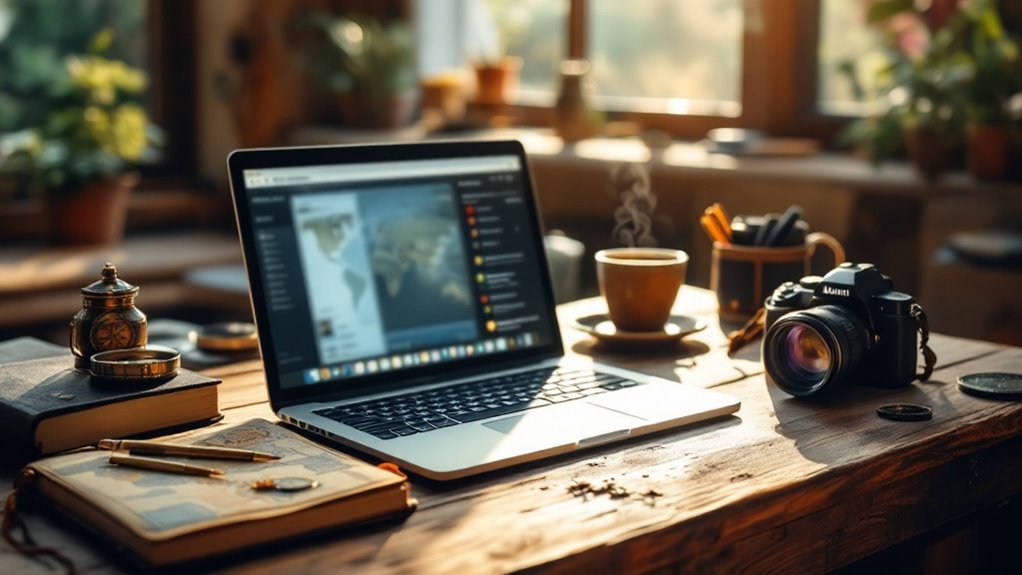
Now that you’ve created compelling content, it’s time to make sure travelers can actually find your blog posts. Search engine optimization (SEO) is essential for increasing your blog’s visibility, and there are several key strategies you’ll want to implement right away.
Consider creating region-specific content like guides to vegan restaurants across Southeast Asia to attract niche audiences. Cities like the city of Graz have thriving plant-based dining scenes worth covering in detail. Food-focused travelers increasingly seek out destinations like Portuguese capital for its growing vegan culinary scene.
Remember to track your rankings through Google Analytics and adjust your strategy based on what’s working best for your audience. Focusing on long-tail keywords can lead to higher conversion rates since these specific phrases target users who are ready to take action.
Building a strong social media presence alongside your travel blog is essential for reaching and engaging with potential readers. Start by focusing on visual platforms like Instagram and TikTok for sharing fascinating travel content, while using Facebook and Twitter for deeper community discussions.
Begin by defining clear objectives for your social media strategy to ensure your efforts align with your blog’s growth goals. Optimize your profiles by maintaining consistent handles across platforms and including clear calls-to-action in your bios that direct followers to your blog.
Develop a content strategy that repurposes your blog content into platform-specific formats, like Instagram carousels or TikTok videos. Join travel-focused Telegram groups and engagement pods to boost your visibility, and track your performance through each platform’s analytics tools.
Schedule regular posts and maintain an 80/20 balance between inspirational content and promotional material to keep your audience engaged.
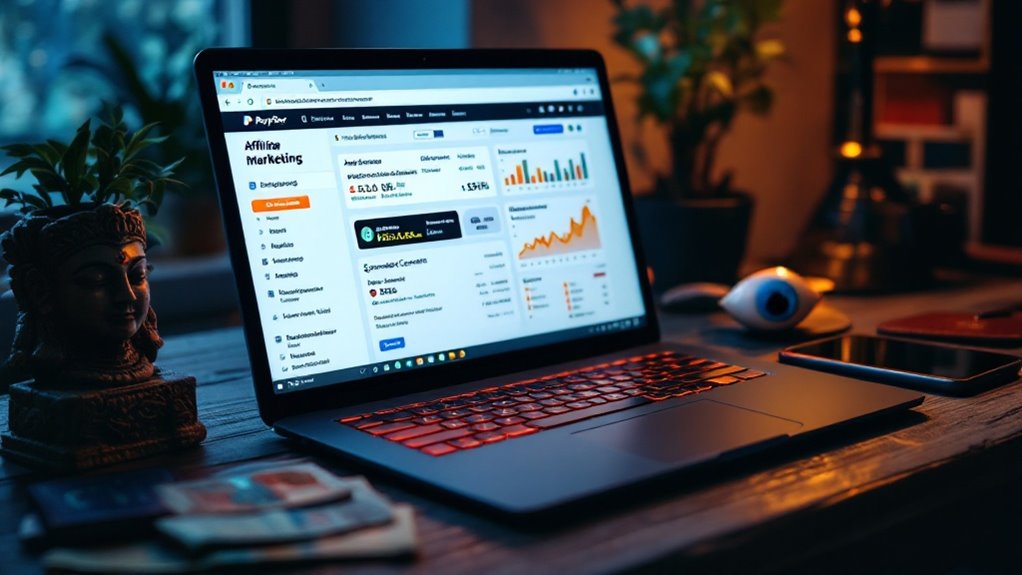
Once you’ve established a strong social media foundation, turning your travel blog into a profitable venture becomes your next milestone.
Start by implementing these proven monetization methods that can help generate diverse income streams.
Building a solid email list allows you to effectively promote your monetized content directly to engaged subscribers who are more likely to convert.
To transform your travel blog from a passion project into a data-driven success, you’ll need to implement robust tracking and analytics systems that measure your site’s performance.
Start by installing essential tools like Google Analytics to monitor traffic sources and user behavior, while using SEMrush or Ahrefs to track your SEO performance and keyword rankings.
Track your blog’s vital signs with Google Analytics for traffic insights and SEO tools like SEMrush for performance data.
Regularly analyze your content’s effectiveness by monitoring metrics such as bounce rates, time on page, and conversion rates through your analytics dashboard. Benchmark your blog’s performance by comparing your metrics against other travel blogs to identify areas for improvement.
Don’t forget to conduct periodic content audits to identify your top-performing posts and update outdated content.
Starting your travel blog doesn’t have to be overwhelming when you break it down into manageable steps. Just look at Kate McCulley of Adventurous Kate, who turned her passion for solo female travel into a six-figure blogging business. You’ve now got the essential roadmap to launch your own successful travel blog – from choosing your niche to tracking performance. Take action today, and you’ll be sharing your travel stories with the world before you know it.